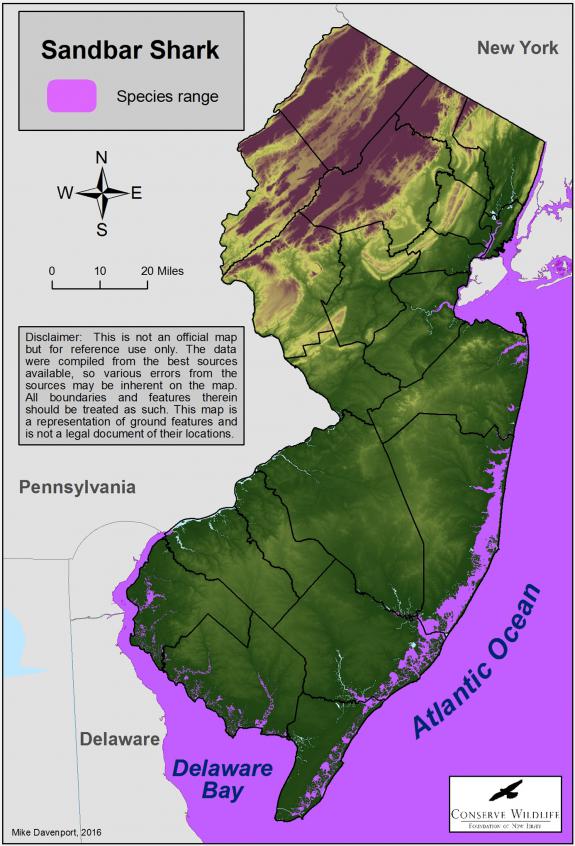Carcharhinus plumbeus
Type: fish
Status: not ranked
Species Guide
Sandbar shark
Carcharhinus plumbeus
Species Type: fish
Conservation Status: not ranked
IDENTIFICATION
Also known as the brown shark, this species can be difficult to identify due to similarities with other species, such as the less common dusky shark. It is a large, fairly slender shark with a low ridge along the back between the dorsal fins. Adults reach a length of 8 feet. Color ranges from grey-brown to bronze above, with a white belly, and with most fin tips dusky in color.
The snout is moderately long and rounded. Upper teeth are broadly triangular and serrated while the lower teeth have narrow cusps and are also serrated. The large first dorsal fin originates over/slightly ahead of the large pectoral fin insert. The first dorsal fin is larger in sandbar sharks than dusky sharks and the origin of the first dorsal is more forward on the sandbar shark.

Distribution & Habitat
The sandbar shark occurs within coastal temperate and tropical waters throughout the world. Within the western Atlantic Ocean, they occur as far north as Cape Cod and as far south as southern Brazil.
This species can be found in bays, harbors, and at river mouths as well as within adjacent deep water often swimming near the bottom. They frequent shallow waters over sandbars, hence their name.
Diet
This species feeds on bony fish, squid, and crustaceans usually on the bottom. They more actively feed at night and are generally not considered to be dangerous to humans. However, they may bite if approached too closely.
Life Cycle
Sandbar sharks are known to live up to approximately 40 years. Males of this species reach sexual maturity when they are approximately 12 years old while females reach sexual maturity at approximately 13 years old. This species reproduces every 2-3 years. Females often show mating wounds – the male bites the female’s back until she rolls over for mating to take place.
This species is viviparous, giving birth to between 1-14 young. The gestation period is believed to be about 8-12 months.
Sandbar sharks migrate annually based on sea surface temperature, often in large schools segregated by age and then by sex when adult. As the water temperature drops in fall and winter, they migrate to deeper warmer water. They have been known to feed in large groups, especially when young. Both the young and adults may fall prey to other larger shark species.
Current Threats, Status, and Conservation
The sandbar shark currently has no federal or New Jersey state conservation status. Though it has no legal conservation status in New Jersey, it is still illegal to take, possess, land, purchase, or sell them within the state.
Reasons for the species decline include illegal landings in both commercial and recreational fisheries and as by-catch, especially from long-line gear. Its slow growth, late maturity, and low rate of reproduction further hamper its recovery. Habitat degradation in coastal waters and nursery areas may impact juveniles. Marine pollution, especially from plastics, also threatens this and many other marine species.
Sandbar sharks are hardy in captivity and are kept in many aquariums.
References
Compagno, Leonard, M. Dando and S. Fowler. 2005. Sharks of the World.
Text written by Michael J. Davenport in 2016.
Scientific Classification
- Kingdom: Animalia
- Phylum: Chordata
- Class: Chondrichthyes
- Order: Carcharhiniformes
- Family: Carcharhinidae
- Genus: Carcharhinus
- Species: C. plumbeus